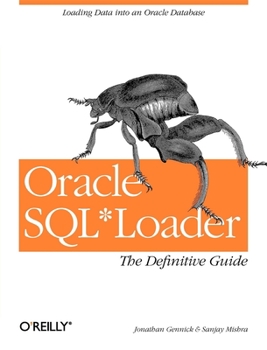Oracle Sql*loader: The Definitive Guide
Select Format
Select Condition 
Book Overview
SQL*Loader is a ubiquitous tool in the Oracle world. It has been shipped with Oracle since at least Version 6 and continues to be supported and enhanced with each new version of Oracle, including Oracle8 and Oracle8i. The job of SQL*Loader is to load data from flat files into an Oracle database. It's optimized for loading large volumes of data, and is flexible enough to handle virtually any input format. Almost every Oracle user has to use SQL*Loader at one time or another, and DBAs are frequently called upon to load data for the users in their organization. Despite SQL*Loader's wide availability and usage, few DBAs and developers know how to get the most out of it. Oracle SQL*Loader: The Definitive Guide has everything you need to know to put SQL*Loader to its best use: an introduction to SQL*Loader, a reference to all of its syntax options, and most importantly, step-by-step instructions for all the SQL*Loader tasks you'd want to perform--and maybe some you didn't realize you COULD perform. You'll learn how to construct the necessary control files and load from different types of files containing different types of data (e.g., fixed-width data, delimited data, and data of various datatypes). You'll also learn how to validate data, load it selectively, transform it as it is loaded, and recover after failure. This book explains how to optimize SQL*Loader performance by adjusting the transaction size and using the new direct path option. It also covers the newest SQL*Loader features--the loading of large object (LOB) columns and the new object types (nested tables, varying arrays, and object tables). Oracle SQL*Loader: The Definitive Guide is an indispensable resource for anyone who is new to SQL*Loader; a task-oriented learning tool for those who are already using it; and a quick reference for every user. If you want to take best advantage of an essential Oracle tool, you need this book.
Format:Paperback
Language:English
ISBN:1565929489
ISBN13:9781565929487
Release Date:May 2001
Publisher:O'Reilly Media
Length:272 Pages
Weight:0.97 lbs.
Dimensions:0.7" x 7.0" x 9.2"
Customer Reviews
5 ratings
No Bull straight to the point
Published by Thriftbooks.com User , 20 years ago
I have been dealing with databases for over three years now. Right now I am doing Siebel Consulting in which Enterprise Integration Module(EIM) is responsible for data transfer from any source to Sieble database. I came across a requirement where I had to use Oracle SQL Loader, so I went looking for a good book. This 250 page book tells you everything you need to know about SQL Loader in less time than any other. Lots of code and real time examples. Worth having as ref book for all DBAs or even developers. Five Stars for sure.
Comprehensive info on SQL Loader all in one place
Published by Thriftbooks.com User , 20 years ago
I searched through several manuals and guides on Oracle only to discover that very few cover the SQL Loader tool in great detail. This book does so, and in a way that's fairly easy to read. It is a huge benefit over the sparse 2-3 pages of documentation you'll typically find elsewhere.
Comprehensive reference
Published by Thriftbooks.com User , 22 years ago
Useful for both new and experienced Oracle DBAs and developers. Initially, some co-workers scoffed, saying that the topic of SQL Loader does not need an entire book on the subject. However, after they looked at my copy, they changed their minds, and wanted to borrow it.
Sql ldr
Published by Thriftbooks.com User , 22 years ago
Very good book on SQL loader. Eveything is in one place and easy to find. Answered all my questions and I got a few ideas about other ways to use SQL loader.
Clearly information collected into one handy reference
Published by Thriftbooks.com User , 23 years ago
Although Oracle does a reasonable job of clearly explaining SQL*Loader, this guide takes it a giant leap forward. First it collects everything you ever needed or wanted to know about SQL*Loader into a 251 page reference. It's written in a friendlier fashion than Oracle's documentation, and with more examples that are better written. On the whole, this promotes a better understanding of SQL*Loader, its strengths and limitations, and will allow DBAs to master every facet and nuance of this powerful tool. Considering the damage that can be inflicted on a production database if SQL*Loader is improperly used, all DBAs who use this tool to load data (and who doesn't?) should read this book and have a copy on their desk.Another use for this book is as a training aid for new DBAs and as the basis for database administration policies and procedures that spell out when and how to load data into a production system. It also contains a wealth of information that can be incorporated into change control implementation and rollback plans when massive updates need to be performed. I like the thorough treatment, the fact that it's up-to-date, and the advice and tips that are imparted throughout this book. It's definitely a good addition to your professional library.





